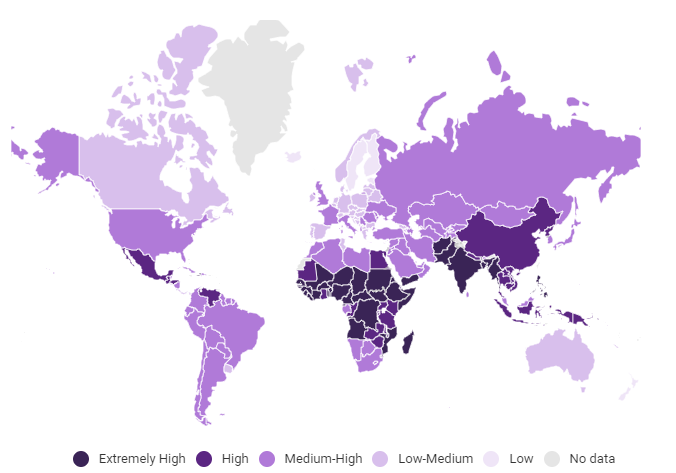Biodiversity & Environment
Children’s Climate Risk Index: UNICEF
- 27 Aug 2021
- 7 min read
Why in News
Recently, the United Nations Children's Fund (UNICEF) in collaboration with Fridays for Future launched a report named ‘The Climate Crisis Is a Child Rights Crisis: Introducing the Children’s Climate Risk Index’.
- It is the first comprehensive analysis of climate risk from a child’s perspective.
- Earlier an analysis, based on Notre Dame Global Adaptation Initiative (ND-GAIN) index, had shown the impact of Climate Change on children across the world.
Level of Climate Risk on Various Countries
Key Points
- Children’s Climate Risk Index:
- It ranks countries based on children’s exposure to climate and environmental shocks, such as Cyclones and Heatwaves, as well as their vulnerability to those shocks, based on their access to essential services.
- Pakistan (14th), Bangladesh (15th), Afghanistan (25th) and India (26th) are among four South Asian countries where children are at extremely high risk of the impacts of the climate crisis.
- Indian Scenario:
- India is among four South Asian countries where children are most at risk of the impacts of climate change threatening their health, education, and protection.
- It is estimated that more than 600 million Indians will face ‘acute water shortages’ in the coming years, while at the same time Flash Flooding is to increase significantly in the majority of India’s urban areas once the global temperature increase rises above 2 Celsius.
- Twenty-one of the world’s 30 cities with the most polluted air in 2020 were in India.
- Global Scenario:
- Countries With Maximum Vulnerability:
- Young people living in the Central African Republic, Chad, Nigeria, Guinea, and Guinea-Bissau are the most at risk of the impacts of climate change.
- These children face a deadly combination of exposure to multiple climate and environmental shocks with a high vulnerability due to inadequate essential services, such as water and sanitation, healthcare and education.
- Impact of Climate and Environmental Hazards:
- Nearly every child around the world is at risk from at least one of the climate and environmental hazards which are Coastal Flooding, Riverine Flooding, Cyclones, Vector Borne Diseases, Lead Pollution, Heatwaves and Water Scarcity.
- An estimated 850 million children – 1 in 3 worldwide – live in areas where at least four of these climate and environmental shocks overlap.
- As many as 330 million children – 1 in 7 worldwide – live in areas affected by at least five major shocks.
- Nearly every child around the world is at risk from at least one of the climate and environmental hazards which are Coastal Flooding, Riverine Flooding, Cyclones, Vector Borne Diseases, Lead Pollution, Heatwaves and Water Scarcity.
- Inequitable Impact:
- There is a disconnect between where GreenHouse gas (GHG) Emissions are generated, and where children are enduring the most significant climate-driven impacts.
- The children from countries least responsible will suffer most of all.
- Climate change is deeply inequitable. While no child is responsible for rising global temperatures, they will pay the highest costs.
- There is a disconnect between where GreenHouse gas (GHG) Emissions are generated, and where children are enduring the most significant climate-driven impacts.
- Children are More Precarious:
- Compared to adults, children require more food and water per unit of their body weight, are less able to survive extreme weather events, and are more susceptible to toxic chemicals, temperature changes and diseases, among other factors.
- Nations Not Meeting the Climate Goals:
- The majority of the carbon emission reduction pledges for 2030 that 184 countries made under the Paris Agreement aren’t nearly enough to keep global warming well below 2 degrees Celsius.
- Some countries won’t achieve their pledges, and some of the world's largest carbon emitters will continue to increase their emissions.
- Countries With Maximum Vulnerability:
- Recommendations:
- Increase Investment:
- Increase investment in climate adaptation and resilience in key services for children.
- Reduce Greenhouse Gas Emissions:
- Countries must cut their emissions by at least 45% (compared to 2010 levels) by 2030 to keep warming to no more than 1.5 degrees Celsius.
- Provide Climate Education:
- Provide children with climate education and greens skills, critical for their adaptation to and preparation for the effects of climate change.
- Include Young People in Decisions:
- Include young people in all national, regional and international climate negotiations and decisions, including at COP (Conference of the Parties- A climate Convention) 26 (It will be held in Glasgow, UK in November 2021).
- Ensure Pandemic Recovery is Inclusive:
- Ensure the recovery from the Covid-19 pandemic is green, low-carbon and inclusive, so that the capacity of future generations to address and respond to the climate crisis is not compromised.
- Increase Investment:
Way Forward
- Meet the Goal:
- In order to avoid the worst impacts of climate change, global net man-made emissions of carbon dioxide must be nearly halved by 2030, and reach “net zero” by 2050.
- Scale up Social Protection System:
- Scale up adaptive and shock-responsive social protection systems – such as grants for pregnant mothers and children - to address the increasing impacts of climate change on children and their families.
- United approach towards child rights:
- More countries need to work towards their commitment in the Convention on the Rights of the Child to ensure every child is protected from poverty, for example by providing universal child benefits to improve children’s well-being and build resilience.







